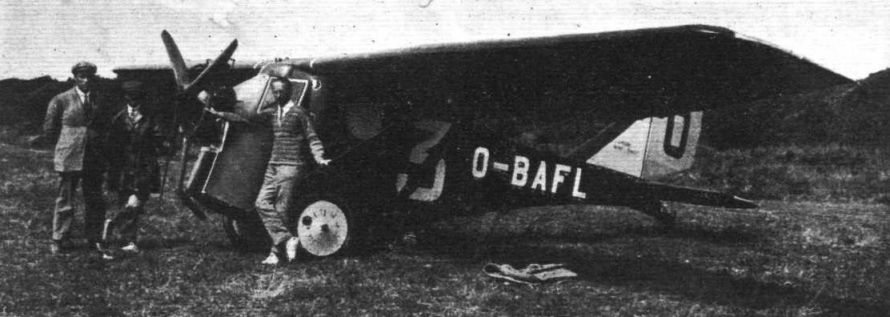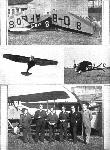SABCA. Самолеты
<...>
К собственным конструкциям компании SABCA относится угловатый расчалочный высокоплан SABCA D.P. Monoplane с мотором воздушного охлаждения Anzani мощностью 50 л. с. В закрытой кабине D.P. Monoplane помещались пилот и пассажир.
<...>
Показать полностьюShow all
Flight, July 1924
THE DEMONTY-PONCELET MONOPLANE
40 H.P. Gregoire Engine
Up to the present but few particulars have become available relating to the light 'planes taking part in the Tour de France des Avionettes, the eliminating trials for which were held at the Bleriot aerodrome at Buc on July 24, 25 and 26, and the start for which took place from the same aerodrome on Sunday, July 27. There are, it will be remembered, 15 machines entered for the competition, of which two are Dutch, two Belgian, two Czechoslovak, and the remaining nine French, except that the machine entered by the Bleriot firm is really to be regarded as a British machine, having been designed and built at Addlestone.
Of the two Belgian machines, one is entered by M. Victor Simonet, who took part in last year's Lympne light 'plane competitions, while the other is a Demonty-Poncelet, designed by the two gentlemen named and built by M. Poncelet. M. Demonty is chief engineer and technical director of the Belgian S.A.B.C.A. works, while M. Poncelet is their works manager. By the courtesy of our French contemporary Les Ailes, we are able to publish this week a brief description and general arrangement drawings of the Demonty-Poncelet monoplane, which shows several unusual features in its design.
The machine, it will be seen, is a high-wing monoplane with strut bracing, and the chief characteristic is that the two occupants are housed inside the cabin, sitting side by side. Owing to the fact that the engine is a four-cylinder-in-line inverted Gregoire, the forward portion of the engine housing is relatively narrow on top, and allows the pilot to look forward from the cabin through windows in the sloping forward walls. Other windows in the sides of the cabin give a reasonably good view laterally, while circular celluloid windows in the roof give an upward view and also improve the lighting of the cabin.
From an aerodynamic point of view the Demonty-Poncelet is chiefly remarkable for a fuselage very deep in front, but tapering off rapidly towards the rear, where, in fact, the curves are slightly "hollow." Whether or not this feature is a good one we should not like to say. The Belgian designers are not alone in choosing it, as it will be remembered that M. Louis de Monge, the famous French designer, has employed these reverse curvatures in some of his machines and is, we believe, of the opinion that these concave curves improve to some extent the resistance figure. It is somewhat difficult to see exactly on what grounds this opinion is held.
Structurally the Demonty-Poncelet is of straightforward type, with wood as the chief material employed. The fuselage has bulkheads of elm and three-ply, with diagonal bracing strips and longerons of elm and covering of three-ply. The latter, incidentally, is of mahogany. The frames or bulkheads in line with the wing spars are specially strengthened and reinforced. The cabin is reasonably roomy, measuring 3 ft. 7 ins. in length, 3 ft. 11 ins. in width and 4 ft. 5 ins. in height. As already mentioned, the occupants sit side by side, and, in addition to the usual seating accommodation, the cabin contains a small luggage compartment and a tool-box. It should be borne in mind that the machine is not so much a light 'plane, in the British sense of the word, as a low-power touring machine, and everything possible has been done to ensure the comfort for pilot and passenger.
The monoplane wing is composed of a centre-section which is part of the fuselage structure and two wing-halves which are so attached as to be rapidly removable for transport. The spars are of spruce and the rear spar is attached to the top corner rail of the fuselage by a universal joint. The front spar is attached by two bolts, and the wings are braced by two wood struts on each side, so arranged as to take tension as well as compression stresses. At the top the two wing bracing struts are joined by a longitudinal piece, while at the lower end the struts are separately attached to the lower longerons, one in front of and one behind the wheel. For folding the wings the front spar bolts are removed, as well as the pins securing the bracing struts to the wing spars, the wing is rotated on the rear spar universal joint, and the wing is folded flat alongside the fuselage, resting with its leading edge on the tail plane. With wings folded the overall width of the machine is only 7 ft. 10 ins., so that it can be trailed behind a motor-car. The two wing halves have their maximum chord and depth at the points of attachment of the bracing struts, tapering to root and tip from this point. It is claimed that owing to the strut bracing, and to the fairly good angle of the struts, the wing strength is very great, while the weight is small, the wings weighing 4-5 kgs./sq. m. (approximately 0-92 lb./sq. ft.), including the bracing struts.
The Gregoire engine is mounted in the nose of the fuselage, and is, as already mentioned, of the four-cylinder-in-line type. It is, however, mounted with its cylinders hanging down and its crank-case uppermost. It is, in fact, this mounting which has made the Demonty-Poncelet possible - at any rate, to a large extent, as the view is only obstructed to a very small extent, much less than would have been the case had the engine been of the usual type. The engine, by the way, is a pre-war type and not very light for its power nowadays, although when it was produced in 1913 it was considered quite a light engine. It is stated to develop 43 b.h.p. at 1,240 r.p.m., and to have a fuel consumption at full throttle of 14-2 litres (3-12 gallons) per hour. The weight is given as 90 kgs. (198 lbs.) dry, and 111 kgs. (245 lbs.) with water and radiator. The radiator is a Lamblin mounted above the top centre-section of the wing. The petrol tank is suspended from the ceiling of the cabin, giving direct gravity feed to the carburettor. The tank is filled from outside, and has a capacity sufficient for three hours.
The undercarriage is of simple type, consisting of a divided axle, hinged in the centre of the floor of the fuselage, carrying two wheels measuring 650 mm. by 80 mm. The rubber shock absorbers are attached direct to the fuselage bottom rails, as in last year's Poncelet machines at Lympne.
The tail is of usual Poncelet type in that there is no fixed tail plane, but a very large balanced elevator. The fin is part of the fuselage, while the rudder is placed wholly above the tail. The tail skid is a leaf spring supported on a substantial swelling or spur on the stern post.
Following are the main dimensions, weights, etc., of the Demonty-Poncelet monoplane two-seater : Length o.a., 6-5 m. (21 ft. 4 ins.); span, 12 m. (39 ft. 4 ins.); height, 2-55 m. (8 ft. 5 ins.); wing area, 18 sq. m. (194 sq. ft.); weight, empty, 330 kgs. (726 lbs.); total loaded weight, 520 kgs. (1,144 lbs.); wing loading, 5-9 lbs./sq. ft.; power loading, 28-6 lbs./h.p.; maximum speed, 125 km.p.h. (78 m.p.h.); landing speed, 50 km.p.h. (31-2 m.p.h.).
Показать полностьюShow all
Flight, August 1925
THE 1925 VAUVILLE MEETING
THE MACHINES
<...>
The Demonty-Poncelet limousine is a high-wing monoplane of very unorthodox design. It was designed by M. Mathieu Demonty, Technical Director of the well-known Belgian firm, S.A.B.C.A., and was built by M. Poncelet. In general arrangement the machine is characterised by a monoplane wing, consisting of a centre-section built integral with the fuselage, and of two end pieces attached thereto by quick release devices. Each wing-half is braced to the lower longerons of the fuselage by long struts, and owing to the great depth of fuselage the angle of the struts is extremely good.
The machine has been designed for touring purposes, and the two seats are arranged side by side inside the cabin, the occupants being able to look forward through windows and sideways through circular openings in the cabin walls, while a window in the floor of the fuselage gives a view downwards. Aft of the cabin is a large net rack for luggage, of which a very considerable amount can be carried, and a tool box is built into the rear portion of the fuselage, ahead of the fin, so that it will be seen that the machine is perfectly equipped for long tours, and is to a large extent self-contained. Should transport along roads become necessary, the wings are so designed that they can readily be folded flat along the sides of the fuselage, the rear spar being provided with universal joints.
The fuselage is a, flat-sided, flat-bottomed structure, covered with three-ply mahogany, and the shape is unusual in that reverse curvatures are found aft of the wing. That this peculiar shape does not adversely affect the efficiency seems to be indicated by the fact that, with a 45 h.p. Anzani, the top speed is in the neighbourhood of 125 km./h. (78 m.p.h.).
<...>
Показать полностьюShow all






